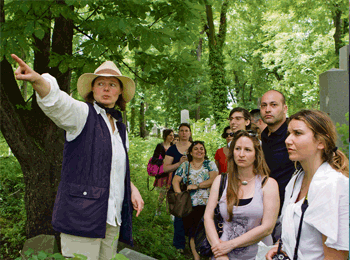For the Jewish Welcome Service Vienna, it was an opportunity to show the next generation that Europe is not a “graveyard.” For us, 14 young professionals from the Toronto area, it was a chance to learn about Jewish life, culture and history in Austria up close.
“It’s something you can’t get by reading a book or taking a course,” said participant Jonathan Spiegelman.
“Experience Jewish Life in Vienna – Past, Present and Future” was the first trip of its kind for Canadian young professionals. The 10-day journey in late May was sponsored by the Sarah and Chaim Neuberger Holocaust Education Centre, UJA Federation of Greater Toronto and the Jewish Welcome Service Vienna.

“My original assumption about Jews living in Vienna was – are there Jews here?” said Spiegelman, 34. “But not only are there Jews here, the impression is for a community of their size they’re quite strong. Jewish life is possible.”
In a city with a population just under two million, there are about 7,000 Jews. There are half a dozen kosher restaurants, a Jewish theatre, multiple synagogues and a Jewish campus that includes a day school and nursing home.
“It’s important to show the young people, especially young Jews from North America, that there is a thriving Jewish community. In Vienna, it’s a small community but it’s a fruitful community,” said Susanne Trauneck of the Jewish Welcome Service. “Not everything is good. There is anti-Semitism, there is racism, but there is also a civil society that tries to stand against it.”
While members of the Viennese Jewish community offered differing opinions as to the extent of current anti-Semitism, recognition of Austria’s Nazi past was universal. The group learned how Austria only began to acknowledge its deadly role in the 1980s, and then began to pay hundreds of millions of dollars in reparation payments to Holocaust victims and their families.
For us, the most tangible example of Austria’s efforts came in the form of Stefan Hammerl. The 20-year-old is among 50 Austrian high school graduates completing a one-year “Holocaust Memorial Service” program abroad as an alternative to mandatory military service. Hammerl, who isn’t Jewish, is spending his year interning with the Neuberger Holocaust Education Centre in Toronto. As part of his program, he helped plan and lead the trip.
“I wanted to show them Jews are welcome in Austria, and that they learn and understand Austria’s past,” said Hammerl. He believes the trip was a success, and said his service also has a broader impact on Austrians.
“To show them a person my age goes abroad, when they hear that they think, ‘Oh wow, and that’s just because of what happened in our past.’ And that’s how they see it’s still important for people to speak about that, for people to teach about that.”
“The goal of the Jewish Welcome Service is always to bring people together for dialogue, and to bring young Jewish people and non-Jewish people together,” said Trauneck. “We all have to stand together against anti-Semitism and racism. Anti-Semitism is not the problem of Jews – it’s all our problem.”
For Spiegelman, the experiences he gained are a starting point for future learning.
“It’s two-fold, strengthening your identity and giving you information you never would have had. In some ways that’s the deepest type of thing you can do to give back, when it almost becomes a part of you, a part of your identity.”
The Jewish Welcome Service Vienna and UJA hope to lead more trips like this in the future.
